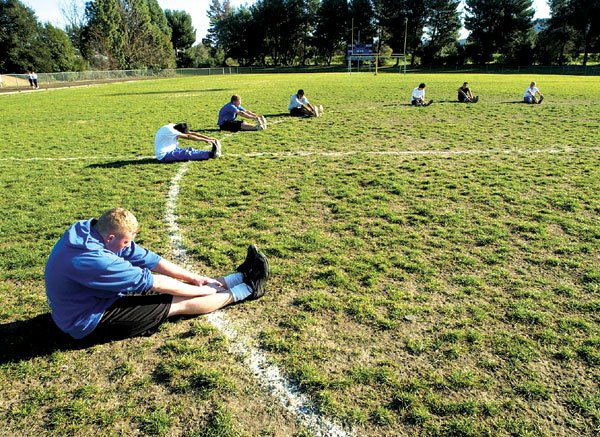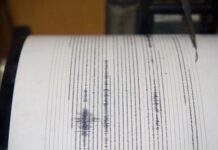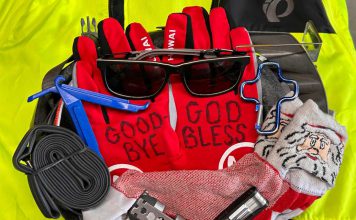GILROY
– The grass on Gilroy High School’s football field could be
greener if the district installs artificial turf this summer.
Replacing the over-used and damaged grass that currently covers
the field with synthetic turf is an option as the district looks at
repairing and maintaining the field for the long run.
By Lori Stuenkel
GILROY – The grass on Gilroy High School’s football field could be greener if the district installs artificial turf this summer.
Replacing the over-used and damaged grass that currently covers the field with synthetic turf is an option as the district looks at repairing and maintaining the field for the long run.
“(The field) hasn’t gotten a lot of rest since August, and there are some major damage areas,” said Jack Daley, athletics director at GHS.
District officials say artificial turf would reduce maintenance costs and, along with other improvements to the GHS stadium, accommodate athletes from Gilroy’s second high school, due to open in 2008.
The GHS track and field both need a major overhaul before next year. Rough estimates for installing artificial turf, as well as resurfacing the all-weather track, run at about $1 million, Superintendent Edwin Diaz said. When the district identified excess funds from Measure J, it saw the possibility of improving the track and field, he said.
The district is looking at several different options for artificial turf and is seeking feedback from high schools that have made the switch. Diaz, facilities staff and high school administrators visited Milpitas High School last week to see its artificial turf, installed last year, and plan to take a look at North Salinas High School, which has a different type.
“I think it would be terrific,” Daley said. “From what I’ve read and all the people I’ve talked to, obviously, it’s playable 24 hours a day, 365 days a year. You see it popping up more and more at the professional level, at the college level and even at the high school level.”
The sidelines and center of the field presently are in the worst shape after heavy usage this year from GHS’ three football teams, Gavilan College’s football team, GHS soccer teams and even Morgan Hill’s football team.
The district also is preparing for accommodating more athletic teams when the second high school opens.
“That field cannot take that type of usage, and if we modify that facility, I would see no need to build another facility at the second high school,” Diaz said.
Portions of the rubber, all-weather track are periodically patched, but since being installed more than 20 years ago, it only has been completely resurfaced once, said Sal Tomasello, principal of Ascencion Solorsano Middle School and former athletic director at GHS.
The school’s broken scoreboard also is being replaced before next school year. The $15,000 scoreboard will be purchased using modernization funds.
Artificial turf or not, the field needs major repairs before next year, said Jeff Gopp, director of maintenance for Gilroy Unified School District. The 2002-03 school year was the first time the soccer teams, or any sport besides football, played games on the field. This year, schools with a lighted field were required to host nighttime games, so every GHS soccer game was played on the deteriorating field. Re-sodding the entire field would cost about $80,000, Gopp said.
By investing more money now, the district may save in the long run by installing a field that is easier to maintain and can withstand use by two high schools’ athletic teams and community groups.
“If we acquire the right product … if it’s done right, yes, it would probably be easier to maintain than the current field,” Gopp said.
The biggest maintenance concerns for the current field are watering, abating weeds and mowing once a week from spring until fall, Gopp said. Those issues would all be eliminated with artificial turf, and lines on the field wouldn’t have to be painted as often, either.
That’s not to say artificial turf is maintenance-free, Gopp said.
“The biggest offender on these artificial fields is chewing gum and sunflower seeds,” he said. “We need to be vigilant on that. You have to have drainage.”
In the past, athletes have complained that artificial turf causes more injury, but studies have offered mixed results and most athletes and medical officials now dismiss the theory.
Milpitas athletes suffered no injuries on their turf this year, Diaz said.
“The technology has really come a long way, I think, that as far as playability and cushioning, it’s not like astro turf,” Daley said. “It’s not a rug rolled down over cement.”
Daley said artificial turf often offers superior playability to real grass because it provides consistent footing and roll of the ball.
“Having the turf would be a great opportunity. It would bring that facility back,” Daley said.
Daley said the turf and repaired track would attract large-scale and regional athletic events to Gilroy once again. Until recently, GHS was frequently host to competitions like Tri-County Athletic League games.
Other GHS students would benefit, too, he said, including: physical education students; marching band and color guard members; and other athletes, such as field hockey players.
The district is proceeding with caution to ensure the project is funded.
“We will not proceed with any of the new projects identified out of Measure J until we know if the state facilities bond passes,” Diaz said.
A $12.3 billion state bond on the March ballot would pay for repairs and upgrades to California’s public schools. Should the bond fail, Diaz said, GUSD would re-evaluate its entire Facilities Master Plan.
Once the district decides on a plan for replacing the field turf, Diaz said, it likely will seek help from Gavilan, the City of Gilroy and other groups that regularly use the field.
Improvements down the road are planned for the GHS stadium, as well.
“There is a longer-term vision for that whole athletic complex that we can look at, as far as being an athletic complex that can serve the entire community,” Diaz said.
Future improvements could include a new snack bar building and a separate locker room facility to host visiting teams and reduce the wear and tear on GHS’ regular locker rooms, Diaz said.













